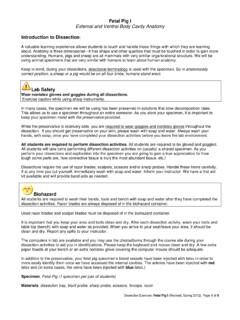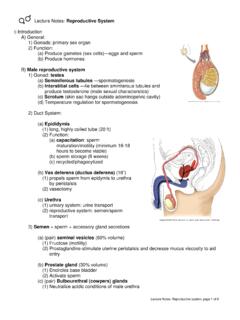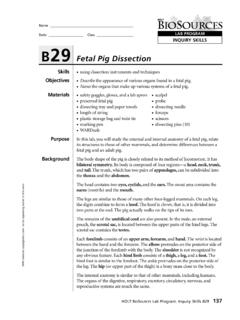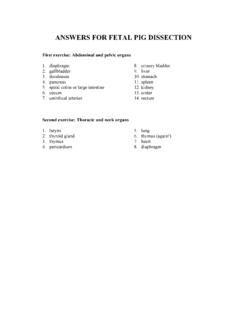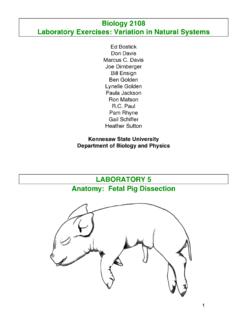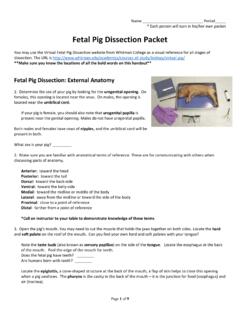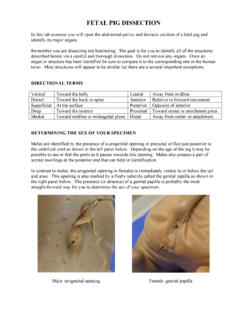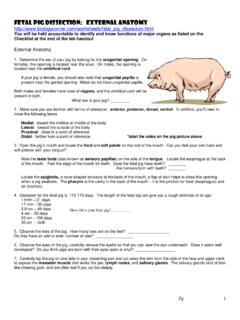Transcription of Adult Pig Heart - North Idaho College
1 dissection Exercise: Adult Pig Heart , page 125 dissection EXERCISE: Adult PIG Heart Introduction: We will be observing the anatomy of an Adult pig Heart because it is much larger than the fetal pig Heart and very similar in size to a human Heart . It will be important to compare the specimen and photographs to the human Heart diagrams in your text book. Lab Safety: All students are required to wear goggles and nonlatex gloves while working with their specimens. Biohazard: All students are required to wash their hands, tools and bench with soap and water after they have completed the dissection activities. Razor blades are always disposed of in the biohazard container. dissection Tools: dissection tray, Blunt probe, Sharp probe, Scissors, Razor Specimen: Adult Pig Heart (1 specimen per pair of students) dissection Exercise: Adult Pig Heart , page 125 Activity 1: External Anatomy of the Adult Pig Heart Observe the following structures on your specimen.
2 Use the diagrams of the human Heart from your textbook, as well as, photos below and the photo album online to help you in those identifications. Procedure: 1. Assemble all of the dissection tools, put on your goggles and gloves and use your dissection tray to transport one specimen to your bench. 2. Examine your specimen and determine if the pericardial sac (pericardium) is still attached to the base of the Heart . If it is, the pericardium and associated adipose should be removed. Use your scissors to make an incision into the pericardium and cut the pericardium away from it s attachment at the base of the Heart . As you cut around the base of the Heart , manipulate the tissues and check for blood vessels (thicker walled arteries and collapsed thin-walled veins). Do not transect (cut) any of the blood vessels that are attached to the Heart . The removal of the pericardial sac should be relatively simple if the sac is attached to the surface of the Heart , it is an indication of pericarditis and should be brought to the attention of your instructor.
3 A. The pericardial sac consists of an outer fibrous connective tissue layer lined with a serous membrane. If you rub your gloved finger on each side of the pericardial sac, you can feel the smooth (serous) side from the rougher (fibrous) side. Serous fluid would fill the space to decrease friction of the Heart as it contracts. b. Covering the surface of the Heart is the second of the serous membranes, the epicardium or visceral pericardium. 3. Once the pericardial sac has been removed, you should be able to identify the ventral and dorsal surfaces of the pig Heart , base, apex (point), right/left atria and ventricles, pulmonary trunk, aortic arch, anterior and posterior vena cava. 4. The coronary blood vessels on the surface within the interventricular sulcus and is used to identify the left and right sides of the Heart . However, these blood vessels lack latex.
4 5. The aortic arch may have several branches off on your specimen. The first branch is the brachiocephalic and the second branch is the left subclavian. Compare the branches of the aortic arch to the branches in your human Heart diagram. Note the differences between the branching patterns in the two mammals. dissection Exercise: Adult Pig Heart , page 126 a. Once you have located the aorta, pass your blunt probe through the aorta and confirm your identification. The blunt probe should access the left ventricle. 6. The pulmonary trunk branches into the right and left pulmonary arteries, depending on your specimen, you may have these blood vessels. If possible, insert your probe through the pulmonary trunk and enter into the right ventricle to confirm your identification. 7. On the dorsal view of your specimen, manipulate the tissues and identify the anterior and posterior vena cava.
5 These veins are very large in diameter, but very thin-walled, so they are usually collapsed and folded. Once you have identified the vena cava, you should be able to place your blunt probe through one of the vena cava and out the other. (See photograph below.) 8. Once you have identified the great vessels attached to the base of the Heart , compare and contrast the structure wall thickness, size of the diameter, ability to change shape, etc. 9. Record your dissection steps, if applicable, and observations in your lab notebook. dissection Exercise: Adult Pig Heart , page 127 Activity 2: Adult Pig Heart dissection In order to view the internal chambers and structures of the Heart , we will be making a series of cuts to observe the semilunar valves, as well as, cutting the Heart open following a coronal plane. Procedure: 1. The semilunar valves are located within the arteries that carry the blood away from the ventricles.
6 A. Use your scissors, blunt side within the lumen, to cut through the thick wall of the pulmonary trunk (do not cut any other structures along the surface. Once you get to the Heart , continue cutting through the wall of the Heart (much thicker) another 3-5 cm. Open up your incision to view the pockets that line the wall of the pulmonary trunk at the junction between the Heart and the trunk which make up the pulmonary semilunar valve. As blood tries to flow back into the ventricle during ventricular relaxation, the blood fills the pocket of the semilunar valves which prevent the blood from returning to the Heart . (See photograph of the pulmonary trunk and pulmonary semilunar valve below). b. Observe the aortic semilunar valve by performing a similar cut through the aorta toward the left ventricle and into the Heart . Choose to make your incision along a pathway that will not damage any other structures along the way.)
7 C. Once you have clear access to the aortic semilunar valve, you will find two openings within the pockets of the valve. These are the coronary ostea. The coronary ostea are the openings that deliver blood into the coronary arteries that serve the cardiac tissue of the myocardium. Place your probe into one of the ostea and view the external anterior surface as you gently wiggle the probe, you should be able to identify a coronary artery that passes beneath one of the atria or along the interventricular sulcus. dissection Exercise: Adult Pig Heart , page 128 2. The Anterior and Posterior vena cava return blood to the Heart from the body. The myocardium, cardiac muscle tissue, is served by the coronary blood vessels. Coronary veins drain into the venous sinus to locate the venous sinus transect the posterior vena cava along its length to the right atrium. Looking inside the lumen of the posterior vena cava you will find an opening, the venous sinus and can pass your blunt probe through the opening which will continue beneath the left auricle (atrium).
8 3. In order to view the internal chambers of the atria and ventricles by creating a coronal plane, use the razor or scalpel (as provided) to cut through the lateral wall of one atria, through the ventricle continuing toward the apex. Repeat the procedure on the other wall, beginning with the atria and continue through the wall of the ventricle toward the apex. Note the thickness of the right and left ventricular wall how does the thickness relate to the ability of each side of the Heart to pump blood through the blood vessels of the pulmonary and systemic circuits? 4. Observe the internal chambers of the Heart . Endocardium is the simple squamous epithelial tissue that lines the chambers and all of the structures within the Heart . 5. Observe the bicuspid (mitral or left atrioventricular valve) between the left atria and left ventricle. The valve includes two flaps which are anchored to the ventricular wall by chordae tendineae ( Heart strings) to a papillary muscle.
9 The irregular surface of the ventricles is the trabeculae carneae and this arrangement allows the Heart to contract synchronously to move the blood in one direction. Compare the tricuspid (right atrioventricular valve) and the internal structures to the left and note the similarities and differences. dissection Exercise: Adult Pig Heart , page 129 6. The fossa ovalis is a remnant of fetal circulation. The foramen ovale originated as a hole within the atrial walll dividing the two atria (interatrial septum). The fossa ovalis consists of a very thin membrane that separates the blood as it enters each atria. By placing your index finger and thumb within the atria and rubbing your fingers together, you can often feel the fossa ovalis as the thinnest part of the wall between the atria. 7. Record your dissection steps, observations and answer the questions in your lab notebook. dissection Exercise: Adult Pig Heart , page 130 This page was left blank intentionally.
10
